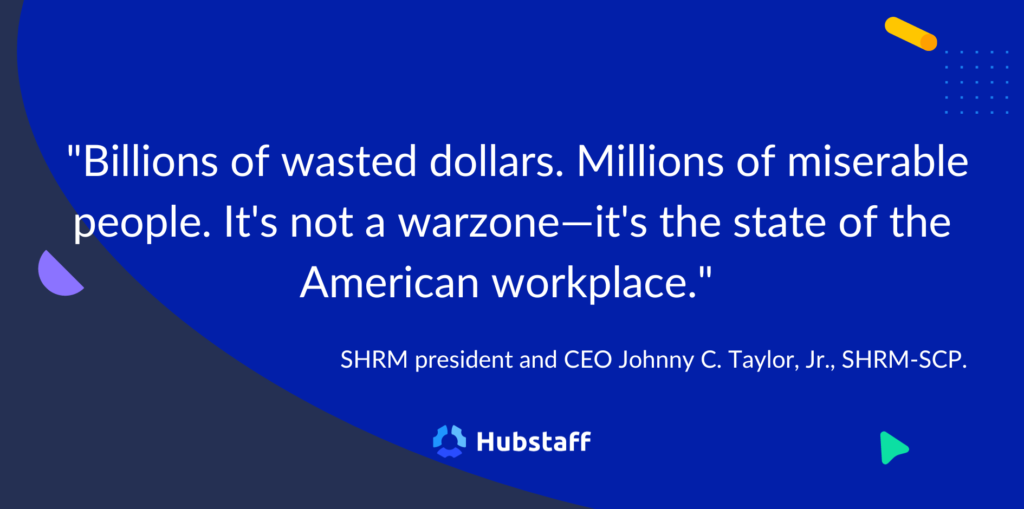MIT’s Sloan School of Management revealed that one in nine employees endure toxic work environments. With over 30 million Americans affected by this statistic, do you ever wonder if you’re applying the correct strategies to improve a toxic work culture?
In this post, we’ll explore symptoms of a toxic workplace and strategies you can use to improve your team’s employee experience. Let’s begin by defining a toxic workplace culture and understanding its effects.
Boost your team’s efficiency with Hubstaff's productivity tools
What is a toxic work culture?
After reviewing 1.4 million employee reviews, analysts determined that toxic workplaces are unethical, non-inclusive, disrespectful, cutthroat, and abusive.
A toxic work culture is like a relentless storm of negativity, where hostility, bullying, and cruelty have seeped into the very fabric of the culture. It’s a place where employees carry the heavy burden of stress and are stifled by blame and ridicule.
The effects of a toxic work culture

To improve workplace culture, it’s important to first recognize the dangers of a toxic workplace.
Here are some of the ways a toxic work culture can negatively affect you and your team:
- Insomnia: Toxic work environments leave team members dwelling on their work-related problems. This hinders their ability to sleep peacefully.
- Attrition: A toxic corporate culture is the strongest predictor of attrition. When it comes to retention, it’s ten times more important than compensation.
- Profit loss: 20% of Americans have left a job in the past five years due to a bad company culture. According to a SHRM report, this turnover’s estimated cost is $223 billion.
- Mental health issues and illness: Toxic workplaces instill fear and chronic stress, which can result in depression, heart disease, cancer, and other illnesses. More than one in five say their work environment has harmed their mental health.
“If I had to distill it down to a core theme, that theme would be fear. “Toxic workplaces drain all the energy and excitement out of employees and replace it with fear.”Mindy Shoss, Ph.D.
Professor and Industrial-Organizational Psychologist
University of Central Florida
Recognizing the warning signs of toxic workplace culture
Spotting signs of a toxic workplace culture is simple. Check the list below for several examples of a toxic workplace culture:
- Bad leadership
- A non-inclusive environment
- Breakdown of trust between leadership and team members
- No transparency in communication
- Overly competitive workplace culture
- Undervalued output and poor compensation
- Lack of enthusiasm (or increase in negative attitudes)
- Lack of clarity on job responsibilities
- Gossip, rumors, finger-pointing, and other toxic behavior
- Overly stressed or burned-out team members
- High turnover and low retention rates
- Low engagement and fear among team members
- A culture of disrespect
- Lack of learning and development opportunities
- Poor work-life balance/increased overtime
- Unethical behavior
How to improve toxic workplace culture
Here are some ideas to help you improve your workplace culture. Remember, improving your workplace culture is an ongoing effort that requires daily attention and commitment.
Be a great leader
Toxic leaders are controlling, tend to micromanage, and often fail to reward or recognize performance. They often fail to address toxic employees, especially if they’re top performers.
A great leader empowers their team, recognizes individual strengths, and skillfully coaches areas of weakness. They cultivate a culture of collaboration and support, actively encouraging peer coaching and fostering the growth of leadership capabilities within the team.
This might come in the form of listening to comments, questions, and concerns through:
- One-on-one meetings
- Surveys
- Daily Stand-ups
In some cases, they may even seek outside professionals to understand and address conflicts or concerns.
Leaders must be honest with themselves and their teams about the workplace environment. Honest communication and feedback can help build trust and address cultural issues.
Build strong values
Establishing and enforcing zero-tolerance policies for toxic behavior sends a message about the importance of a healthy workplace. A thoughtful exploration of your organization’s core values will represent the guiding principles and ideals that inspire your team and influence their actions.
These values may include things like:
- Teamwork
- Respect
- Professionalism
- Transparency
- Innovation
- Trust
- Accountability
An important value to consider is providing a psychologically safe work environment. Psychological safety encourages employees to voice ideas and concerns without fear of punishment. A safe environment fosters a sense of trust and belonging, enhances collaboration, improves culture, and supports innovation.
Once you identify your core values and clearly communicate them to your team, you must live them. Lead by example. Demonstrate these core values in your own actions and decisions. When leaders embody the values, it sets the tone for the rest of the organization to follow suit.
Create a positive employee experience
The employee experience includes moments that influence how employees perceive their employer’s purpose, brand, and culture. Improving the employee experience goes hand in hand with improving workplace culture.
A positive remote/hybrid employee experience increases productivity, morale, and well-being. Organizations should set reasonable productivity standards to create a positive remote employee experience that helps:
- Promote work-life balance
- Manage work-related stress
- Foster a sense of belonging
- Ensure employees are happy with their working arrangements
Hubstaff supports remote, hybrid, and flexible work environments by enabling productivity, building company culture, and improving resource management.
Investing in remote employee experience leads to reduced turnover, happier employees, increased productivity, and higher profits — all contributing to improved workplace culture.
Be transparent and respectful when communicating. Clear communication builds trust and provides clarity for employees. Encourage work-life balance and respect your team’s boundaries — especially after normal working hours, on weekends, and during vacations.
Develop interesting roles with opportunities
Give your team members flexibility by allowing them to work independently and take ownership of their roles and responsibilities. Empower your team by offering opportunities for personal and professional growth. Encourage lateral career moves, engaging side projects, and thought-provoking challenges to ensure they remain inspired and motivated in their roles.
Opportunities for learning and development enrich employees’ work lives, improve workplace culture, and enhance performance. Training, tuition reimbursement, leadership development, and coaching can benefit employees and employers.
Employees should understand the impact of their work on the organization’s mission and vision. Effective leaders set achievable goals demonstrating the team’s impact, inspiring purpose, and employee dedication.
Final thoughts
Recognizing and addressing toxic workplace cultures is crucial for employee well-being and organizational success. As mentioned at the beginning of this post, research reveals that millions of American team members are forced to endure these environments.
To improve workplace culture, focus on:
- Great leadership: Empower, recognize, and coach. Prioritize honest communication and feedback.
- Strong values: Establish zero-tolerance policies and define core values like teamwork, respect, and transparency.
- Positive employee experience: Promote work-life balance, stress management, and a sense of belonging.
- Transparent communication: Build trust with clear, respectful, and transparent communication.
- Opportunities: Empower employees with flexibility, autonomy, and growth opportunities.
Implementing these strategies can help detoxify your workplace culture. Remember that this is an ongoing effort requiring commitment from all levels of the organization.
Most popular
The Critical Role of Employee Monitoring and Workplace Security
Why do we need employee monitoring and workplace security? Companies had to adapt fast when the world shifted to remote work...
15 Ways to Use AI in the Workforce
Whether through AI-powered project management, strategic planning, or simply automating simple admin work, we’ve seen a dramatic...
The AI Productivity Panel: Lessons From Leaders on What’s Working (and What’s Not)
When I moderated this AI productivity panel, I expected a solid conversation. What I didn’t expect was the flood of real-world i...
Employee Performance Dashboards: Templates, Tools, and Best Practices
Keeping track of how your team’s really doing can be tricky. Spreadsheets pile up, one-on-ones only tell part of the story, and...





